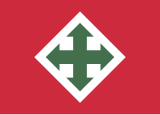Nyilas
|
Arrow Cross Party – Hungarist Movement
Nyilaskeresztes Párt – Hungarista Mozgalom |
|
|---|---|
 |
|
| Leader |
Ferenc Szálasi 1935–1945 (executed for war crimes) |
| Founded |
|
| Dissolved | April 1945 |
| Headquarters | Andrássy út 60, Budapest |
| Membership | 300,000 in 1939 |
| Ideology |
National Socialism Hungarian Turanism Agrarianism |
| Political position | National Socialist |
| Religion | Roman Catholicism |
| Colours | Red, White, Green (from the flag of Hungary) |
| Anthem | Awaken, Hungarian! |
| Party flag | |
 |
|
The Arrow Cross Party (Hungarian: Nyilaskeresztes Párt – Hungarista Mozgalom, literally "Arrow Cross Party-Hungarist Movement") was a national socialist party led by Ferenc Szálasi, which led a government in Hungary known as the Government of National Unity from 15 October 1944 to 28 March 1945. During its short rule, ten to fifteen thousand civilians (many of whom were Jews, Romani and Serbs) were murdered outright, and 80,000 people were deported from Hungary to various concentration camps in Austria. After the war, Szálasi and other Arrow Cross leaders were tried as war criminals by Hungarian courts.
The party was founded by Ferenc Szálasi in 1935 as the Party of National Will. It had its origins in the political philosophy of pro-German extremists such as Gyula Gömbös, who famously coined the term "national socialism" in the 1920s. The party was outlawed in 1937 but was reconstituted in 1939 as the Arrow Cross Party, and was said to be modeled fairly explicitly on the Nazi Party of Germany, although Szálasi often and harshly criticized the Nazi regime of Germany. The iconography of the party was clearly inspired by that of the Nazis; the Arrow Cross emblem was an ancient symbol of the Magyar tribes who settled Hungary, thereby suggesting the racial purity of the Hungarians in much the same way that the Nazi swastika was intended to allude to the racial purity of the Aryans. The Arrow Cross symbol also referred to the desire to nullify the Treaty of Trianon, and expand the Hungarian state in all cardinal directions towards the former borders of the Kingdom of Hungary.
...
Wikipedia
